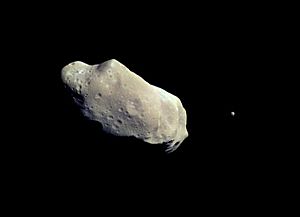243 Ida facts for kids

Galileo image of 243 Ida. The tiny dot to the right is its moon, Dactyl.
|
|||||||||||||
| Discovery | |||||||||||||
|---|---|---|---|---|---|---|---|---|---|---|---|---|---|
| Discovered by | Johann Palisa | ||||||||||||
| Discovery date | September 29, 1884 | ||||||||||||
| Designations | |||||||||||||
| A910 CD; 1988 DB1 | |||||||||||||
| Main belt (Koronis) | |||||||||||||
| Orbital characteristics | |||||||||||||
| Epoch October 22, 2004 (JD 2453300.5) | |||||||||||||
| Aphelion | 447.843 Gm (2.994 AU) | ||||||||||||
| Perihelion | 408.207 Gm (2.729 AU) | ||||||||||||
| 428.025 Gm (2.861 AU) | |||||||||||||
| Eccentricity | 0.046 | ||||||||||||
| 1767.724 d (4.84 a) | |||||||||||||
|
Average orbital speed
|
17.60 km/s | ||||||||||||
| 245.469° | |||||||||||||
| Inclination | 1.138° | ||||||||||||
| 324.218° | |||||||||||||
| 108.754° | |||||||||||||
| Known satellites | Dactyl | ||||||||||||
| Physical characteristics | |||||||||||||
| Dimensions | 53.6×24.0×15.2 km | ||||||||||||
|
Mean radius
|
15.7 km | ||||||||||||
| Mass | 4.2×1016 kg 1 | ||||||||||||
|
Mean density
|
2.6 g/cm³ 1 | ||||||||||||
|
Equatorial surface gravity
|
0.0109 m/s² | ||||||||||||
|
Equatorial escape velocity
|
0.0185 km/s | ||||||||||||
| 0.1931 d (4 h 37 min) 2 | |||||||||||||
| 0.2382 3 | |||||||||||||
|
|||||||||||||
| S | |||||||||||||
| 9.94 | |||||||||||||
243 Ida is a Main belt asteroid with pictures taken by the Galileo spacecraft on August 28, 1993. It was the first binary asteroid to be found and is a member of the Koronis family of asteroids.
Discovery and name
Ida was found by Johann Palisa on September 29, 1884 in Vienna. It is named after Ida, a Cretan nymph in Greek mythology who lived on a mountain that has her name (see Mount Ida, Crete).
Moon
Ida has a small moon, Dactyl, which was found on February 17, 1994 by Galileo mission member Ann Harch, while examining the delayed image downloads. The moon was given the designation S/1993 (243) 1 and later named (243) Ida I Dactyl. The pictures where it was first seen were taken on 28 August 1993, hence the designation. The moon was reported on 12 March 1994.
Dactyl is only 1.4 km in diameter. Some researchers believe that Dactyl formed from debris blown off from Ida because of cratering, while others suggest that Ida and Dactyl formed as a pair a billion or more years ago when Ida's parent body was disrupted. Both of these theories present difficulties that are unresolved at this time. Since Dactyl was found, other sightings have suggested that asteroid moons are common.
Although Ida's dimensions, measured along the principal axes (based on its rotation) are 53.6×24.0×15.2 km, the best-fit ellipsoid measures 60.0×25.2×18.6 km. Since its mass is well known thanks to its little moon, one can calculate that its surface gravity can be between 0.0031 and 0.0324 m/s². The rotation axis is within one degree of the shorter dimension axis, which means the centrifugal effect can reach a value as high as 0.0042 m/s² — at the tips of its longest axes, Ida is actually under tension.
Related pages
- P. C. Thomas, M. J. S. Belton, B. Carcich, C. R. Chapman, M. E. Davies, R. Sullivan, and J. Veverka; The shape of Ida, Icarus, Issue 1, No. 120, pp. 20–32, 1996.
- M. E. Davies, T. R. Colvin, M. J. S. Belton, P. C. Thomas, J. Veverka, The Galileo Imaging Science Team, The North Pole Direction and the Control Network of the Asteroid 243 Ida, Bulletin of the American Astronomical Society, Vol. 26, p. 1154, June 1994
- The Asteroid Orbital Elements Database
Images for kids
See also
 In Spanish: (243) Ida para niños
In Spanish: (243) Ida para niños







